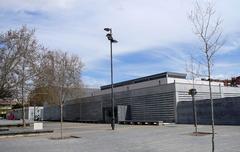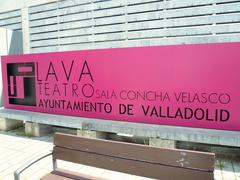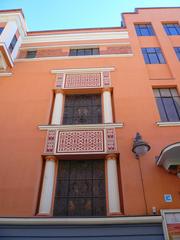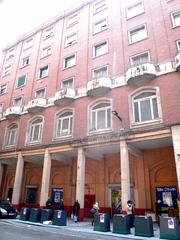Visiting the Convent of Las Descalzas Reales in Valladolid, Spain: Tickets, Hours, and Tips
Date: 04/07/2025
Introduction
Nestled in the historic heart of Valladolid, the Convent of Las Descalzas Reales stands as a testament to Spain’s intertwining of royal legacy, monastic tradition, and artistic achievement. Founded in 1559 by Joan of Austria, daughter of Emperor Charles V and Empress Isabella of Portugal, this convent transformed a former royal residence into a sanctuary for the Poor Clare nuns. Over centuries, it has served as a spiritual haven for noblewomen, a repository of priceless artworks and relics, and an enduring symbol of religious devotion and royal patronage.
This guide explores the convent’s rich history, architectural marvels, artistic treasures, and provides practical visitor information, ensuring a rewarding and respectful experience for all who wish to discover one of Valladolid’s most treasured landmarks.
Historical and Cultural Significance
Foundation and Royal Patronage
Joan of Austria, seeking solace and religious fulfillment after her widowhood, founded the Convent of Las Descalzas Reales in her birthplace. The Poor Clare nuns, known for their austere lifestyle and barefoot devotion, found in this former palace a haven of peace and contemplation. The convent quickly became a preferred refuge for widowed and unmarried noblewomen, whose substantial dowries enriched the convent with valuable artworks and relics (Spain Travel Express).
Spiritual Traditions
The convent’s community embraced the Franciscan ideals of poverty, humility, and prayerful seclusion. Notably, each novice brought a crucifix and an image of the Christ Child as part of her dowry, symbolizing spiritual union with Christ (Madrid Secreto). The convent remains renowned for its annual “Divine Nursery” (Divina Guardería) event during Christmas, featuring a remarkable collection of over 120 Nativity figures.
Artistic and Relic Collections
Las Descalzas Reales houses more than 400 relics and reliquaries, including remains of early Christian saints and martyrs, many encased in intricately crafted gold and silver containers (Madrid Secreto). The convent’s artistic holdings include Brussels tapestries inspired by Peter Paul Rubens, paintings attributed to El Greco, and a recumbent Christ by Gaspar Becerra. The grand staircase, possibly adorned by Velázquez, and the cloisters are among its architectural highlights (Spain Travel Express).
Architectural Features
Layout and Structure
Occupying a prominent position in central Valladolid, the convent extends across Calle de Ramón y Cajal, San Martín, and Calle del Prado (Visitar Valladolid). Originally two noble houses, the structure was modified to ensure the seclusion of its cloistered community, including the replacement of balconies with windows fitted with blinds (Digital History Unite). The complex encompasses a church, two cloisters, chapels, monastic quarters, and a large orchard.
Façade and Cloister
The exterior features harmonious stone and masonry construction, with two main entrances. Above the principal doorway, a niche houses a statue of the Assumption, attributed to Gregorio Fernández (MyCityHunt). Royal coats of arms of Philip III and Margaret of Austria are displayed prominently, attesting to royal patronage (Visitar Valladolid). The cloister, a perfect square with two levels of arches supported by Tuscan columns, retains its original design and a central well (MyCityHunt).
Church Interior
Designed by Francisco de Mora, the church features a single nave with a dome and a main altarpiece adorned with sculptures by Gregorio Fernández and paintings by Santiago Morán (Digital History Unite). The Baroque iron pulpit, with its wooden canopy, stands out as a well-preserved decorative element.
Monastic Dependencies
Key spaces include the De Profundis room, decorated with religious paintings from the royal collection, and the refectory, which features a 17th-century depiction of the Last Supper (Visitar Valladolid). The convent’s orchard, enclosed by a high stone wall, offers a rare urban sanctuary for meditation.
Artistic Heritage
Sculptures and Paintings
The convent’s main altarpiece is a masterpiece of Spanish Baroque, with expressive sculptures by Fernández and paintings by Morán. The De Profundis room further enriches the site’s artistic ambiance, housing works connected to the royal collections and the school of Juan Pantoja de la Cruz (MyCityHunt).
Decorative Arts and Royal Patronage
Baroque ironwork, geometric flooring, and ornamental coats of arms throughout the building reflect the close relationship between the convent and the Spanish monarchy (Digital History Unite). The fixed number of thirty-three nuns—symbolizing Christ’s age—and the requirement of royal approval for each novice underscore the institution’s privileged status.
Preservation and Living Heritage
Declared a National Monument in 1974, the convent continues to house an active community of cloistered nuns, preserving the legacy of its founders and maintaining the authentic atmosphere of a centuries-old monastic enclave (MyCityHunt).
Visiting Information
Location and Access
The convent is centrally located in Valladolid’s San Pablo district, opposite the Palacio de los Vivero and within walking distance of major landmarks such as the Museo Nacional de Escultura and Colegio de San Gregorio (Trek Zone).
- On Foot: Easily accessible from Plaza Mayor and surrounding areas.
- Public Transport: City buses stop nearby; check current schedules.
- By Car: Limited city center parking; public garages are available within walking distance.
Visiting Hours
As of 2025, typical visiting hours are:
- Monday to Saturday: 10:00 AM – 2:00 PM and 4:00 PM – 7:00 PM
- Sundays and Public Holidays: Closed or limited morning hours
Check for updates before your visit, as hours may change due to religious or restoration activities (Trek Zone).
Tickets and Guided Tours
- Standard Admission: €8 per person for guided tours
- Free Admission: Available on designated days; tickets must be obtained in person (Patrimonio Nacional).
- Groups/Education: Special rates apply; educational groups require a booking fee.
Guided tours are mandatory to protect the site and respect the cloistered community. Tours are generally in Spanish, but English tours may be available upon request. Advance booking is highly recommended, especially during peak times (Patrimonio Nacional).
What to Expect
Tours (45–60 minutes) include:
- Main cloister and Renaissance architectural highlights
- Convent church with its altarpieces and art
- Chapels and communal spaces
- Commentary on history, the Poor Clare nuns, and monastic traditions
Photography is generally not permitted inside.
Accessibility
The historic nature of the building means some areas have uneven floors and narrow corridors, limiting full accessibility. Ramps and elevators are available in select areas. Visitors with mobility concerns should contact the convent in advance.
Visitor Etiquette
- Dress modestly (shoulders and knees covered)
- Maintain silence, especially in sacred spaces
- No food, drink, or flash photography inside
Best Times to Visit
- Spring (April–June): Pleasant weather and lighter crowds
- Autumn (September–October): Comfortable temperatures and vibrant local events
Avoid peak summer afternoons and check for public holidays that may affect opening hours (Best Time To).
Nearby Attractions
Enhance your visit by exploring:
- Museo Nacional de Escultura: Renowned collection of Spanish sculpture (5 min walk)
- Colegio de San Gregorio: Historic 15th-century building (5 min walk)
- Valladolid Cathedral: Unfinished Renaissance cathedral (7 min walk)
- Teatro Calderón: Historic theater (6 min walk)
- Palacio de los Vivero: Directly across from the convent
Frequently Asked Questions (FAQ)
Q: Are guided tours mandatory?
A: Yes, all visits are via guided tours to ensure preservation and respect for the nuns.
Q: Is photography allowed inside?
A: Photography is generally prohibited except in designated areas.
Q: Are there free entry days?
A: Yes, on select days; tickets must be collected in person.
Q: Can I visit on Sundays or public holidays?
A: The convent is usually closed or has reduced hours on these days. Confirm ahead.
Q: Are English-language tours available?
A: Occasionally, depending on demand. Inquire in advance.
Tips for an Enriching Visit
- Book ahead: Especially during holidays or peak seasons.
- Arrive early: Allows for a relaxed check-in and tour experience.
- Combine visits: Plan to explore nearby Valladolid historical sites.
- Dress appropriately: Respect the religious setting.
- Be mindful: Respect the nuns’ privacy and the convent’s sacred spaces.
Visuals and Online Resources
For a preview of the convent’s architecture and collections, visit official sites or tourism platforms. Virtual tours, high-quality images, and interactive maps are available through the Patrimonio Nacional website and local tourism resources.
Contact and Further Information
- Address: Convento de las Descalzas Reales, Distrito 9 (San Pablo), Valladolid, Spain
- Official Tickets & Info: Patrimonio Nacional
- Tourist Info: Valladolid Tourist Office
For current hours, tickets, and any special events, always check the official ticketing site.
Conclusion
The Convent of Las Descalzas Reales in Valladolid offers a profound encounter with Spain’s religious, artistic, and royal heritage. Its serene cloisters, remarkable artworks, and ongoing monastic life invite visitors to step back in time and experience centuries of devotion and culture. With guided tours, central location, and proximity to Valladolid’s finest attractions, it is an essential stop for any cultural traveler. Plan ahead, respect the site’s traditions, and immerse yourself in the timeless beauty of this extraordinary convent.
Ready to delve deeper into Valladolid’s heritage? Download the Audiala app for audio guides, curated tours, and the latest visitor information. Stay connected through our social channels for news, tips, and inspiration.
Sources and Further Information
- Visitar Valladolid
- Spain Travel Express
- esMadrid
- Trek Zone
- Council of Europe
- Madrid Secreto
- Patrimonio Nacional
- Digital History Unite
- MyCityHunt
- Best Time To




